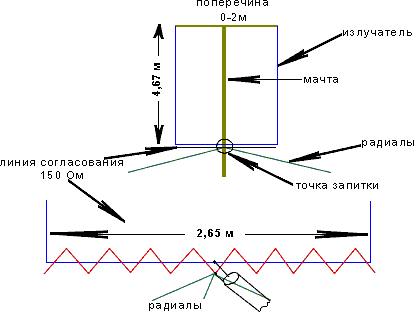So, put up for the public option multi-band antenna designed for work on the SW bands 20-17-15-12-10 meters, and also at any intermediate range, interested, for example, Shibitov. In addition, the antenna operates at higher frequencies than 28-29 MHz, limited to the lower strap - 20m range. The antenna can be counted on the lower ranges - for example from 40 meters, and again only the lower range will limit broadband antennas.

If you take a CushCraft vertical or HihgGain, think about how much it costs. This antenna will cost You just spent the time looking for the wires and the measurement of its length. In General the gift. The antenna can be easily placed on any of our roof, it is only necessary to think where to attach the radials.
For each range, you need 3-4 radial at the required resonant frequency. If one range will be 2 different radial lengths (the beginning and the middle of the range, for example), broadband antennas increases within range. The length of the radial equal to 1/4 wavelength. Count as the canvas half-wave dipole by a simple formula: the length of the radial L(m) = 1/2*(142500/f(kHz)). The frequency f is chosen based on what range you expect.
For example:
The calculation for the range 20 m:
L=1/2* (142500/14200) = 5.017 m
L=1/2*(142500/14010) = 5.085 m
Got two lengths, based on the fact that You need to work in CW and SSB site, make 2 for each radial frequency.
The more radials, the greater the efficiency of the antenna, but this is a truism known from the theory, in this case, the more radials on one range, the fewer failures on the CWS. Do not place the radials in a variety of ranges close to each other. The slope of the radials in relation to the horizontal't need to do bolshe-20 degrees. But parallel to the ground, too, in this case a very small angle of the main lobe of the antenna.
Line approval 150 Ohms can be made as follows: take the cable a little over 2.65 m, put him in a thick vinyl chloride tube and wrap around the emitter (figure highlighted in blue). About 20 turns of the coils on the entire length of the line. The Central bottom point of the emitter is attached lived power, and is wound over the wire - braid; to the point of connection with braid mounted radials.
The mast and the top cross member better be made of insulating material. The cross member may not be, then the ends of the antenna are reduced to a single point at the top, but not shorted. The length of the crossover depends on the broadband range of 10 m, as it is the widest section of the frequencies. The closer pivoted ends, the antenna sirokopolosnie. I advise you to choose an average length of 1.2 - 1.5 m. But to extend the range of possible different radials (see above). Testing antennas in the range of 10 m is made with the radials only on the frequency 28400 kHz showed the following results:
Frequency
CWS
28000
2,2
28100
1,8
28150
1,6
28200
1,4
28300
1,2
28390
1,1
28450
1,2
28500
1,4
28600
1,6
Other bands occupy a relatively small frequency band, and the results were as follows:
Frequency
CWS
14010
1,2
14050 it was
1,2
14100
1,1
14150
1,05
14200
1,1
14250
1,2
14300
1,25
21010
1,5
21100
1,4
21150
1,3
21200
1,4
21250
1,5
On the bands 18 and 24 MHz I have radials installed yet, despite it all section of these ranges, the CWS was not above 1.5.
The radiation pattern along the bottom line of the main power petals at the expense of phasing two vertical shoulders of the antenna.
The antenna has a gain of about 5-6 dB relative to a dipole on the current range, at 20 meters. The point is already something! In other ranges of the parameters of the antenna depend on the quality of matching lines. Can cook a wire with a diameter of 2-3 mm and to start manufacturing.
Developers and testers: RW4NA and UA4NBH
Author: Andrei Korsakov (RA4NF), This email address is being protected from spambots. You must have JavaScript enabled to view it. ; Publication: www.vti.vyatka.ru/~ham, www.cxem.net






